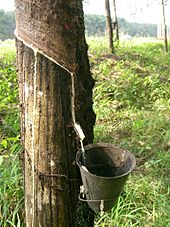
Back مطاط طبيعي Arabic প্ৰাকৃতিক ৰবৰ Assamese Natuakautschuk BAR প্রাকৃতিক রবার Bengali/Bangla Rwber naturiol Welsh Naturkautschuk German Caucho natural Spanish Kautšuk Estonian لاستیک طبیعی Persian Caoutchouc naturel French



Rubber, also called India rubber, latex, Amazonian rubber, caucho, or caoutchouc,[1] as initially produced, consists of polymers of the organic compound isoprene, with minor impurities of other organic compounds.
Types of polyisoprene that are used as natural rubbers are classified as elastomers.
Currently, rubber is harvested mainly in the form of the latex from the Pará rubber tree (Hevea brasiliensis) or others. The latex is a sticky, milky and white colloid drawn off by making incisions in the bark and collecting the fluid in vessels in a process called "tapping". Manufacturers refine this latex into the rubber that is ready for commercial processing.
Natural rubber is used extensively in many applications and products, either alone or in combination with other materials. In most of its useful forms, it has a large stretch ratio and high resilience and also is buoyant and water-proof.[2][3]
Industrial demand for rubber-like materials began to outstrip natural rubber supplies by the end of the 19th century, leading to the synthesis of synthetic rubber in 1909 by chemical means. [citation needed]
Thailand, Malaysia, Indonesia, and Cambodia are four of the leading rubber producers.[4][5][6]
- ^ Dunstan, Wyndham Rowland (1911). . In Chisholm, Hugh (ed.). Encyclopædia Britannica. Vol. 23 (11th ed.). Cambridge University Press. p. 795.
- ^ Dananjaya, Vimukthi; Somarathna, Yashoda; Siriwardena, Susantha; Sirimuthu, Narayana; Karunanayake, Laleen; Abeykoon, Chamil (1 May 2024). "Effects of latex type and processed-mica waste loading on the structural and thermo-physical properties of natural rubber latex foam composites". International Journal of Lightweight Materials and Manufacture. 7 (3): 450–466. doi:10.1016/j.ijlmm.2023.12.002. ISSN 2588-8404.
- ^ Phomrak, Sirilak; Nimpaiboon, Adun; Newby, Bi-min Zhang; Phisalaphong, Muenduen (29 August 2020). "Natural Rubber Latex Foam Reinforced with Micro- and Nanofibrillated Cellulose via Dunlop Method". Polymers. 12 (9): 1959. doi:10.3390/polym12091959. ISSN 2073-4360. PMC 7565547. PMID 32872461.
- ^ Sirimaporn Leepromrath, et al. "Rubber crop diversity and its influential factors in Thailand." Journal of Rubber Research 24.3 (2021): 461–473.
- ^ Muhammad Fadzli Ali, et al., "The dynamics of rubber production in Malaysia: Potential impacts, challenges and proposed interventions." Forest Policy and Economics 127 (2021): 102449.
- ^ Fadhlan Zuhdi, "The Indonesian natural rubber export competitiveness in global market." International Journal of Agriculture System 8.2 (2021): 130–139 online.